The architectural significance of Camelview Theater has been doubted by many, impacting whether people think it’s worth saving. Contributing writer Walt Lockley did some digging and discovered that the architect of Camelview Theater was actually a significant and talented midcentury modern architect who has designed some amazing buildings throughout the country. He also explains how Camelview Theater fits within the larger context of the architect’s work. Find out more about Edo Belli and how he came to design a theater in Scottsdale, Arizona in 1972.
Walt Lockley was born in Texas, educated from the back seat of a 1972 Buick Riviera criss-crossing the country, and lives in Portland, Oregon.
A few of us are trying to save a movie theater in Scottsdale. It’s called the Camelview 5. It’s been the primary art house for the entire state of Arizona for decades. It’s comfortable and familiar and 20% shabby, the same way Film Forum in Greenwich Village fits around you like your lucky leather coat, lived in and worn with pleasant memories, the thing you always wear for foreign-language and limited-release movies.
Camelview 5 will soon be ripped apart by backhoes and hauled away in ragged chunks if we don’t do something about it. A huge shopping mall across the parking lot must expand. Its California owners say so. Two million square feet is just not big enough for Fashion Square.
Meet the Camelview
Born in 1973, the Camelview is the third-oldest movie house in the valley, one of those stylish midcentury landmarks newly popular in the last five years, a prime remnant of the valley’s years of wild growth and architectural improvisation. In style, year, and spirit it fits brilliantly on the same page alongside the exaggerated branch banks, the science-fiction churches, and all the others. It’s a midcentury marvel.
First a twin cinema, now a five-plex, the one-story Camelview building has always been distinguished by the oddity of three large steel parasols in the entry. Somehow their three differing heights are comically human, like three players in a mariachi band. Once they stood relatively dignified, the color of rusted Cor-Ten steel, but now they’ve been painted a gaudy 80s aquamarine, their tops lined with flexible LED rope light, and equipped with misters for the blistering summer months.
Until a couple of weeks ago the Camelview 5 was an orphan. From dogged searching a designer’s name finally came out: Belli & Belli of Chicago. I’m familiar with many American architects’ names and reputations. The name Belli & Belli meant absolutely nothing to me. They might have designed bowling alleys and high schools in Kankakee out of a car trunk, for all anybody knew.
So it will strain the patience of Fashion Square’s owners to suddenly claim that the Camelview 5 is not a piece of disposable vernacular junk, like everybody thought, but the work of an experienced architect with a master’s touch, that this architect was a nationally significant Modernist with a major and very personal body of work, that this master Modernist is unknown even within the profession, that those three steel parasols make better sense — perfect sense — in the context of a career full of spectacular mind-boggling oddity, and that NRHP designation for the Camelview 5 is not a crazy idea. But those are my claims. Here’s my case.
Back to Belli
We’re really talking about one man, the founder of the firm, sole designer, and driving force, Edo J. Belli. Born in 1918. Died in 2003.
You can almost hear Edo Belli speak. In November 1983 he sat for one of Betty Blum’s Chicago Architects Oral History Project interviews. This by itself marks him as a significant figure. His cadence and emphasis come through clearly as he covers his personal history.
He opened his practice in 1941. He’d apprenticed with the Holsmans in Chicago in the hungry 1930s and graduated, with a great deal of effort to scrape by and educate himself professionally, from the Armour Institute of Technology in 1939. All through the war Belli served as a Seabee, the sign of very good training in tough conditions. Then his brother Anthony joined him in the practice after World War II. They did their own engineering, and operated as a design-and-build operation — meaning, no construction slippage, no misinterpreting the plans. They wrote the score and they played the music too. They still do. Edo’s sons Allen and James continue to run the firm.
There’s an anecdote that explains how Belli landed so much business from the Roman Catholic Church.
Early in his career, during a business meeting with his priest client and the Chicago Archbishop Samuel Stritch about the proposed conversion of an apartment building into a Catholic school, one ill-advised moment of candor got him fired. The Archbishop good-humoredly questioned him, paraphrased here, “Edo, if you were me, you would buy what you’re selling?” Belli blurted out, “No. It’s like putting new shoes on a bum.” End of meeting. Project scrapped. The priest client was so infuriated by Belli’s stupidity, he refused to drive Belli back home. Two days later, as if in a corny movie about hard-working immigrants, word came from the Archbishop that he would fund an entirely new building. Belli walked away with a major commission and the Archbishop’s amused attention, which grew into friendship, then into a meaningful mentorship.
St. John Bosco Church. Copyright Nate Lielasus, all rights reserved.
Within the archdiocese there was an existing system, a machine, for parcelling out church-related commissions. These were good jobs. Remember this is Chicago. Belli began by taking the work others passed up, for apparently poor parishes or unappealing projects out in the outskirts, and delivering buildings the parishes could be proud of. But from the very beginning he put himself at odds with church tradition, and all other architectural conservatism, by committing himself to a risky modernist style. “Even if a plan insisted on following the traditional style,” he said, “we would always try to inject something (contemporary).” He specifically cites Eliel Saarinen, of all people, as an influence.
But he did well. This was a specific moment in postwar architectural history when public and private schools across America, underfunded and stretched out of shape by the demographic baby-boom bulge, turned to modernist architects out of sheer desperation. Because modernism was cheap.
Through Archbishop Stritch, Belli became acquainted with John F. Cuneo some time in the 1950s. Cuneo was tough, single-minded, devoutly Catholic, and vastly wealthy. Cuneo held annual birthday parties for the archbishop at his mansion, the mansion that once belonged to Samuel Insull, the mansion which contained a papally-consecrated chapel as well as a popular dairy and amusement park called Hawthorne Mellody Farms essentially in the back yard. Every year these parties climaxed with the archbishop receiving another new Cadillac for his birthday. The three of them got to be good friends.
Cuneo had various building projects on the boards: a major hospital, an entire shopping mall, improvements to the dairy, etc.. He needed an architect. He wanted Belli. Belli claims to have resisted at first but he soon had (along with the Chicago Archdiocese) a multimillionaire as a steady client and long-term collaborator, for the hospital and for mall development projects in Niles, in Houston, and in Scottsdale.
Marillac Hall at the University of Missouri-St.Louis. Courtesy Chris Naffziger, all rights reserved.
As if that wasn’t enough, the Daughters of Charity, based in St. Louis, chose Belli & Belli to handle their entire hospital building program for both renovations and new builds all around the midwest. The firm grew large and hit its financial stride during the 1950s, 60s, 70s. At its height Belli & Belli operated five related corporations in the midwest, ran their own plane and pilot, and attracted majors international clients as walk-ins. (“This,” they’d say, pointing to a photograph. “How did you do this? Do this for us.”) Eventually they accumulated more design work than Edo Belli as the sole designer could handle. There’s a natural limit to what one man can accomplish. This gave him ulcers. Instead of delegating or opting for carelessness, he chose to pull in, remain focused, stay small. He was active as a designer through the late 1980s at least.
Secretly famous
Once or twice in the Betty Blum interview Belli charmingly refers to himself as “Edo Belli” in the third person, as a brand, a personage, as the proud name of a developed style. You imagine him dressing with precision and flair. He did a brilliant job of advancing his architectural career. Cuneo, this baron, called him “the shrewdest businessman I ever knew.”
What “Edo Belli” never did was develop a signature design or seek publicity of any kind. He apparently didn’t care about getting published.
So his name is not well known.
Within the tight competitive club of Chicago architects Belli earned respect as their equal. Stanley Tigerman had kind words for him, and he deeply impressed Bertrand Goldberg, if Goldberg’s subsequent work is any measure. (Was it Goldberg who talked about the virtue and necessity of starting from scratch every single time?) Belli’s work shows signs of the best kind of discipline, concerned with aesthetics and user experience and technically innovative all at the same time, working at that tender inflection point between engineering and sculptural effect.
Betty Blum asked him which of his designs he would show to an interested student.
“If a man was interested, for instance, in concrete, I’d take him over to St. Gertrude Church because it was the first concrete shell that was ever used in a church. If a man was interested in catenary roofs, I’d take him to Notre Dame High School for Boys, because there we built a roof to span 160 feet in one direction and 180 in another, with a three-eighths inch steel plate. If he was interested in rigid frames and what you could do with a steel frame, I’d take him over to St. Pat’s, where we spanned the gym with just a plate structure. So there are a lot of things that go into it. If he was interested in wood, we’d take him down to Kankakee, where we did a school in laminated wood. If he was interested in shapes, again, we’d take him to St. Pat’s and to Kankakee, where we built, I think, probably the first circular school. In fact, I’ll go one better than that. St. Joseph Hospital was designed in two cylinders, similar to Marina Tower, three years before Marina Tower was off the ground. And it ends up that Bertrand Goldberg was on the committee when St. Joe was being planned and approved, so where did he get the idea of Marina City?”
The AIA gave him an Honor Award for Excellence in Architecture in 1955 (for St. Patrick’s High School), a Citation of Merit in 1955 (for the St. Nicholas School in Aurora), and a Citation of Merit in 1957 (for St. Gertrude Church in Franklin Park). There would have been more if he and the AIA hadn’t fallen out. Four of his designs were featured in a 1993 Art Institute Design Exhibition, which made him cry. Earlier this year the Chicago Reader called him “the most important Chicago architect you’ve probably never heard of.”
All this is great to talk about, with sober appreciation and respect for this Catholic master, until you get a look at the work.
You’ll laugh out loud.
Atomic Catholicism
St. Joseph’s Hospital designed by Belli. Copyright Nate Lielasus, all rights reserved.
I’d start at the 1963 St. Joseph’s Hospital on Lake Shore Drive. From outside you’re going to notice the thirteen floors of glossy blue lozenges on the building’s windowless flanks, and an auto entrance straight from a Morris Lapidus luxury hotel: a long three-story curving panel of blue glass topped with a happy regular ripple of wagging concrete eyebrows, a blue glass tower with half-circle carbuncles like jewel-box drawers pulled out, a surfacy grid of patient room windows like a child’s drawing of windows, among other eye-catching features.
You see that a stylistic category like “Atomic Catholicism” isn’t exaggeration. “Jesuit Populuxe” maybe. What you can’t see are the operating rooms, tiled in merry clashing glazed tiles in early 1960s colors and perfectly round in plan, or the Dan Ryan Chapel. The AIA Chicago guide, with amused horror, called the Dan Ryan Chapel perhaps the city’s most perfectly preserved 1960s interior. “Architects would like to think the 1960s looked like Mies’s Federal Center, but this is what that era really looked like.” They don’t explain how beautiful and bizarre it is.
Cuneo Chidlren’s Hospital. From Flickr user dvhunter (Devin Hunter), used under Creative Common license Attribution 2.0 Generic.
The logical next stop would be the 1957 Frank Cuneo Children’s Hospital, currently the focus of a preservation battle. Equally eccentric, fresh but obviously old, a different flavor entirely. Cuneo Hospital is a low-rise, six-story essay in strong curved concrete, funded of course by John F. Cuneo, on the North Shore at Clarendon and Montrose.
Quite serious compared to St. Joseph’s. Both have elaborate chapels and circular surgical theaters. Both are cited against the street grid for dramatic effect. But the Cuneo’s seventh story is a rooftop terrace with a curved roof of its own in the shape of a painter’s palette, a bold and graceful Corbusian finial, and it is connected by a silvery skybridge to an adjoining Extended Care Facility dating from 1974, very much of its own brutalist time, also a Belli design, yet another flavor.
Melanie Eckner of the preservation group Friends of Cuneo points out that Cuneo Hospital’s rooftop terrace not only had a therapeutic function for young patients but functions as part of a clever passive ventilation system. It catches the high breeze from Lake Michigan. The perfectly round surgical rooms were meant for efficient cleaning. She maintains that Belli’s progressive frame of mind and his unusual schooling allowed him to leap to these perfectly rational, apparently bizarre design solutions. As attested to by street interviews, the widest variety of Cuneo’s users and neighbors from all walks of life respond to Cuneo as a civic asset.
Work down the list of known commissions, in 18 states and six countries, large and small. If there’s any ‘tell’ in Belli’s work, it’s a cut-out circle or a structural circle in plan. It’s not always there. All the known projects have their own distinct flavors, as if Belli started from scratch every time.
At Golf Mill Mall you get a completely round jazzy mid-Century office tower, like the Capitol Records Building. The series of white concrete domes of 1987 St. Benedict the African Church in Englewood, a late design that reveals something about the long consistency of Belli’s thinking, is reminiscent of Wallace Harrison when turned loose to experiment. The 1953 St. Gertrude Church has an early concrete shell and a nice demonstration of “structural bravado”. The 1957 St. Nicholas School in Aurora and the 1959 St. Stanislaus Kostka School on the north side are both elegantly proportioned, inexpensive, controlled designs that show an easy familiarity with Corbu; elsewhere you can detect consonant echoes of Saarinen, or Niemeyer, or a whiff of the Eastern bloc. Belli’s originality is never in question. On the contrary.
And there’s this about “Atomic Catholicism”: the apparent paradoxes between sober, serious Catholic faith and Belli’s sensual sense of humor can be jarring to the eye at first. Those are some mixed signals. The contradiction is both uncomfortable and refreshing, a spin on expectations. But if you think for a moment there’s no paradox there really. Not really. That’s parochial nonsense.
Camelview’s heritage
Which brings us back to Scottsdale.
In the early 1970s, after a long break in their relationship over a billing dispute, Edo Belli heard from John F. Cuneo through his lawyer. (His lawyer, by the way, was John Paul Stevens, soon to be appointed to the Supreme Court.) Cuneo had been to Arizona to be closer to his grandchildren. He’d found some property for a mall project.
Arizona Bank Tower. © 2004 Joey Robert Parks
Belli was summoned and reluctantly came, with his son Allen, and built the 10-story Arizona Bank tower, the Sakowitz store, the Bullock’s store, and Camelview 5. Now that we know Belli a little better, that circular hole on the Camelback side of Neiman’s is a little more meaningful. Maybe there’s a good logical reason. Maybe not.
Camelview’s three steel parasols, the three mariachi players, slip into much better focus. Edo Belli had spent a long, successful career making architectural gestures nobody had seen before. There’s just something about those parasols that’s memorable, distinctive, surreal. There’s a touch of mysterious certainty. Melanie Eckner of Friends of Cuneo wrote, “To me, the fact that so many people have come to love Camelview theater without knowing or thinking about who might have designed it, is in many ways the key to Belli’s magic.”
In an interview Allen Belli didn’t remember if they were originally his idea, or his father’s. But he confirmed they were meant to produce both shade and indicate a theatrical moment of arrival. From this umbrella idea in Scottsdale, they developed a grander idea in a church they designed across the country, at Our Lady of Victory in State College Pennsylvania, a couple of years afterward. The interior of that church is structured around a single stylized tree, a working metaphor done all in laminated wood.
Which brings us, finally, to what I’ve avoided saying. Allen Belli laughs gently, audibly shaking his head, when asked if there’s a commission list. “Oh,” he said, “there were years when we only did churches.”
There is no good list. There’s too much work, that’s the problem. Edo Belli was a prolific designer for forty years. He designed entire campuses in South Dakota, suburban St. Louis, Indiana, other places, physically remote and lightly documented, some effectively abandoned. There are something like 1700 projects in the archives. I know of about thirty. Even allowing for how project files work, it’s not possible that we’re missing some major, amazing work. It’s a sure thing.
Of course Friends of Cuneo and Save Camelback will be encouraging Belli & Belli to open their archives and sit for more interviews. Of course there’s going to be more exploration. This is fertile ground, an important career.
It’s just worth noting, at this moment, dozens and maybe hundreds of Edo Belli’s very personal designs all across the country wait to be identified and recognized.
Meanwhile, here in Scottsdale, Camelview 5 is one of the few we know about. And it might just get torn down.
Major work
– Marmion Abbey, 1000 Butterfield Road, Aurora, Illinois, now Marmion Academy, multiple buildings, 1950.
– St. Patrick’s High School, 5900 W. Belmont, Chicago, 1952-1956.
– St. Gertrude Church, 9613 Schiller Blvd, Franklin Park, IL, 1953.
– St. Nicholas School, 312 N High St, Aurora, Illinois. AIA award in 1957.
– Frank Cuneo Children’s Hospital, 720 W. Montrose Ave., Chicago, 1957.
– St. Stanislaus Kostka School, 1255 N. Noble, Chicago, 1959.
– Moreau Seminary campus, Notre Dame Indiana, 1959.
– multiple buildings on the Marillac College campus, Normandy, Missouri, now occupied by UM St. Louis, including the dorm (1960, with Greubel & Saletta of Evansville, Ind), Marillac Hall, and the Ward E. Barnes Library.
– St. William Church & Rectory Chicago, 2600 N. Sayre, Chicago, 1960.
– Immaculate Conception Church, 200 Edmund Street, Pittsburgh, Pa, 1961.
– St. Joseph’s Hospital, 2900 N. Lake Shore Drive, Chicago, 1963.
– Golf Mill Professional Building (round 10-story tower), Golf Mill Mall, Niles Illinois, 1963, for John F. Cuneo, with the Mill Run Playhouse, 1965, razed 1984.
– Clelian Heights School for Exceptional Children in Greensburg, Pennsylvania, 1968.
– Camel View Plaza, Scottsdale, Arizona, 1974, including Sakowitz, Bullock’s, 20 other stores, Arizona Bank Tower, Camelview 5. Radically modified: tower and cinema remain in more or less original shape.
– Frank Cuneo Memorial Hospital Extended Care Facility, Chicago, Illinois, 1975.
– St. Benedict the African Church, 340 W. 66th Street. Englewood, 1987.
[To join the preservation effort for the Camelview 5 in Scottsdale, see the Facebook group Save Camelview! and sign the change.org petition
Lead image: Camelview Theater. Courtesy of Walt Lockley.















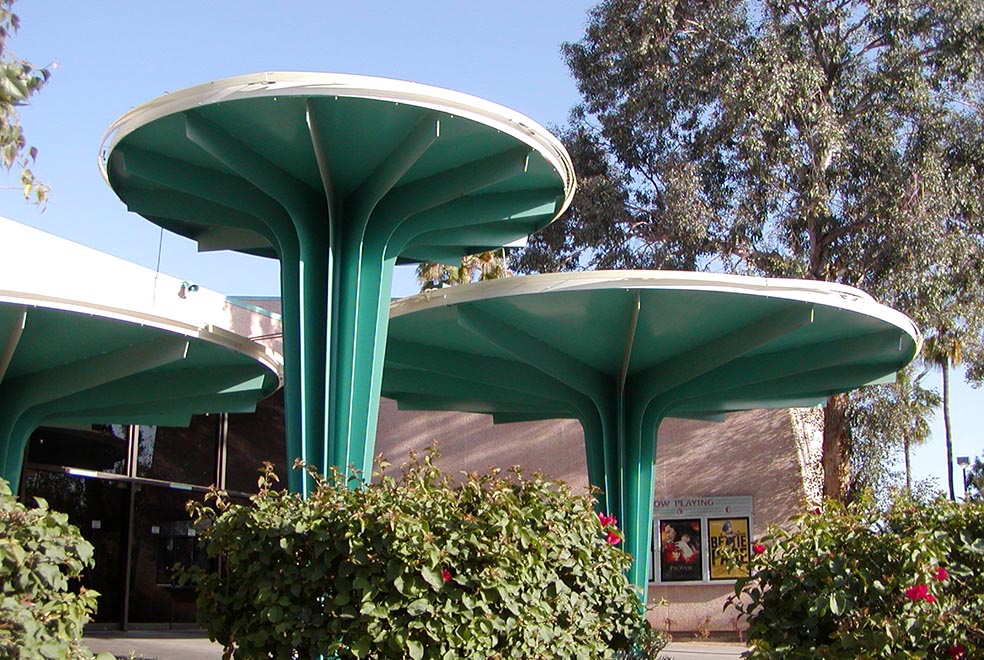
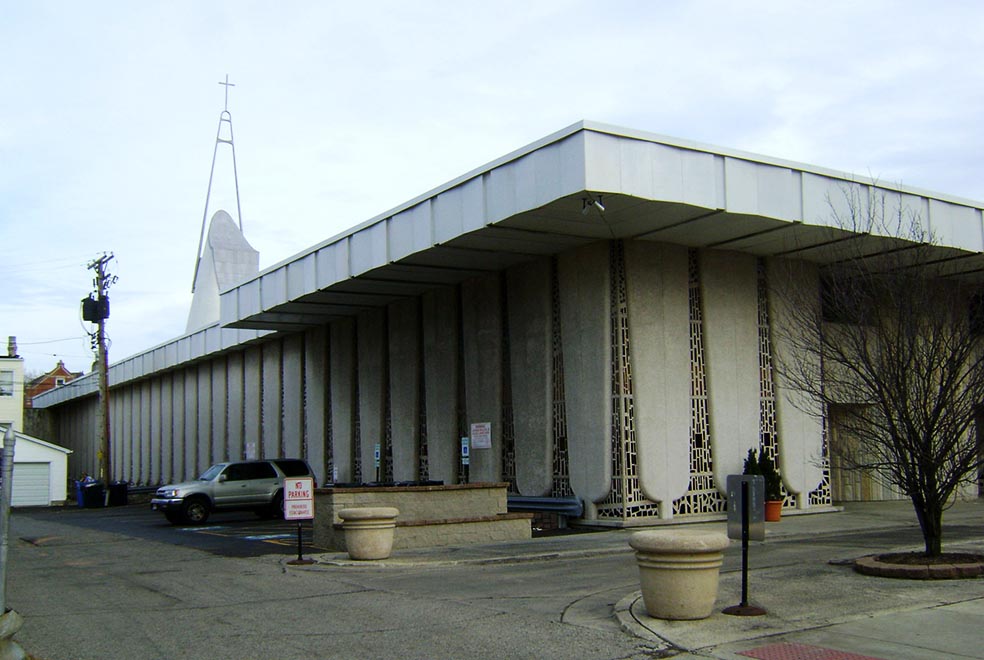
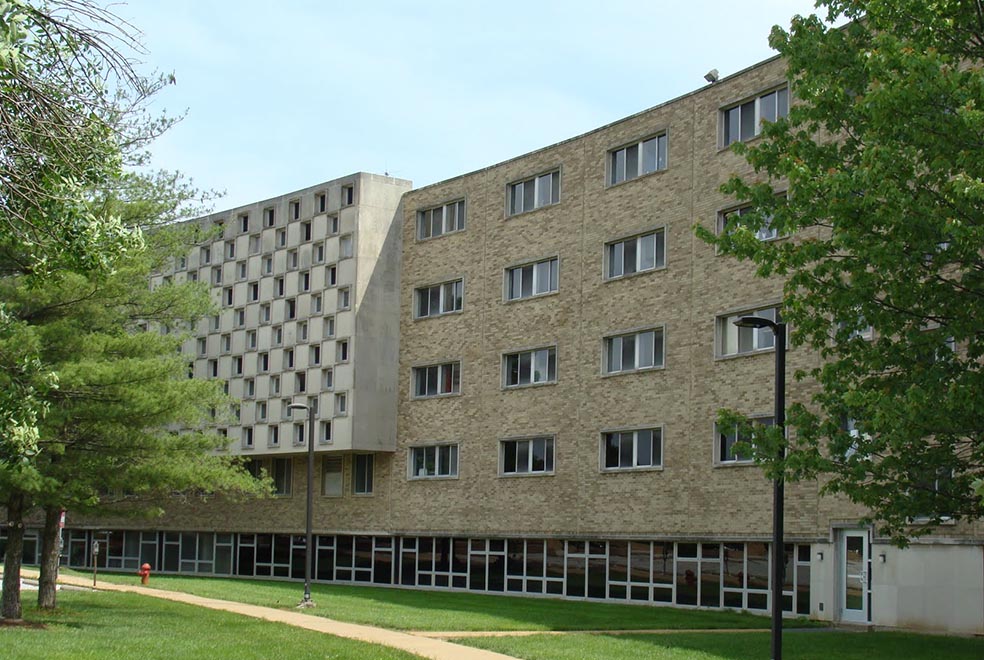
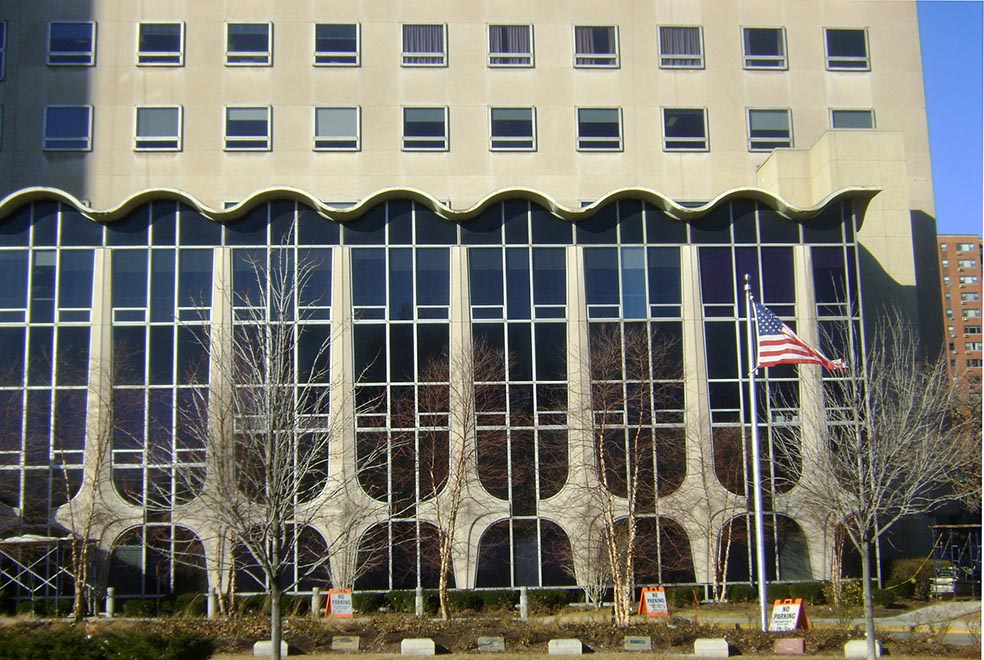
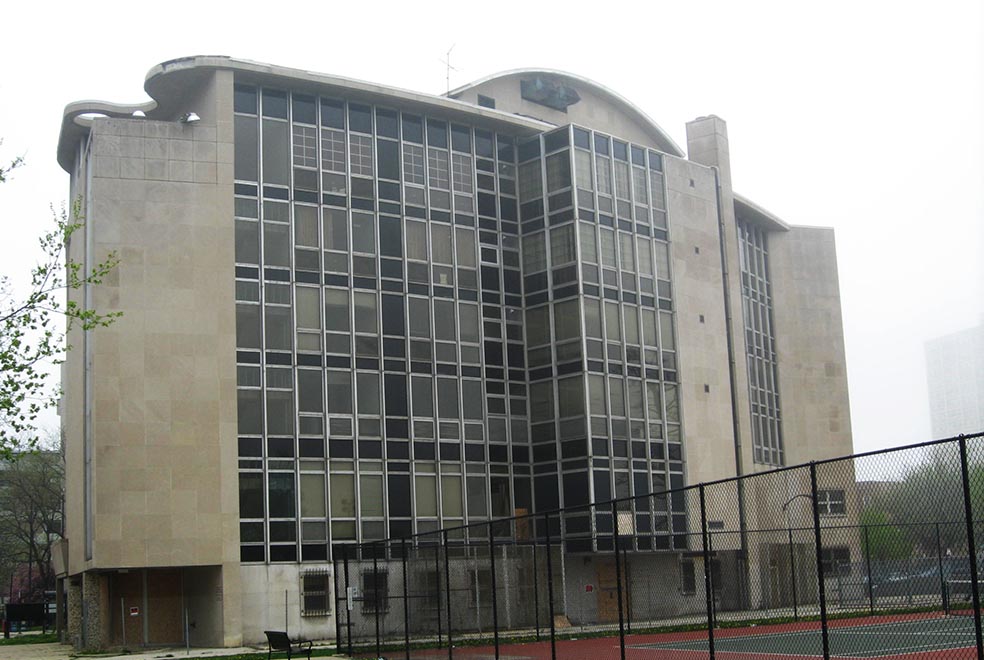
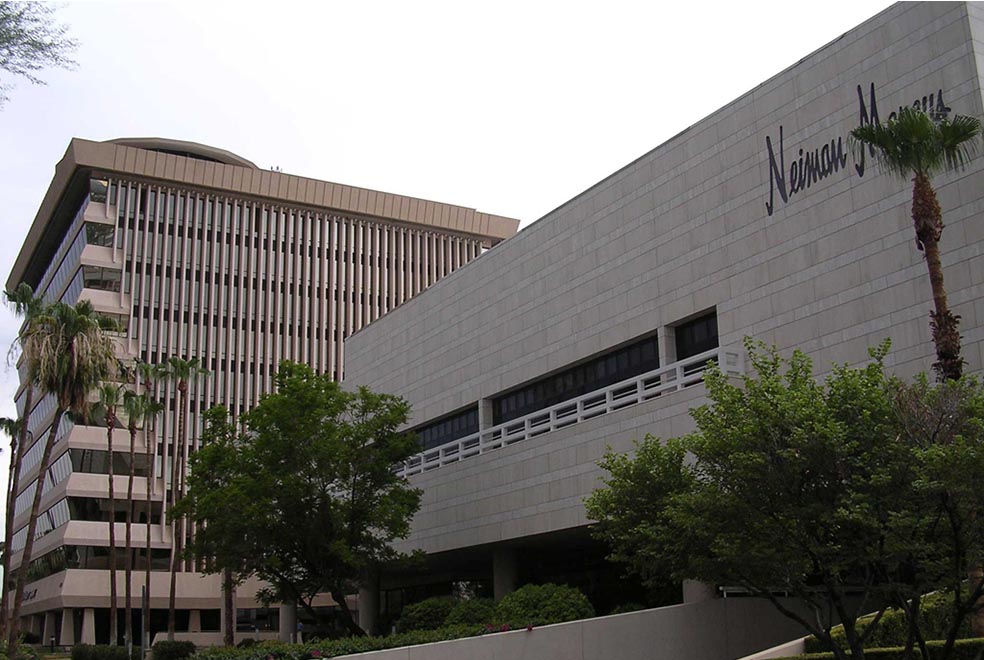




Fascinating and quite interesting!
There are many such architects, the ones who do not seek publicity (good or bad). They simply do what they are trained to do, seek enjoyment and satisfaction from what they have designed.
Thanks for doing the research on the Camelview!
Let me urge everybody to stop by the Friends of Cuneo Hospital petition and sign up. Tonight — literally right this minute — there’s a zoning & development committee meeting deciding Cuneo’s fate. It’s not looking good right now. Please click and sign here:
http://www.change.org/petitions/city-of-chicago-save-cuneo-hospital
Thanks for your support!
[…] building. The visibility of the project has even brought to the fore several other quirky and endangered Belli buildings in other cities (at least for […]
It would’ve been nice to see a full view/unobstructed pic of the three ‘umbrellas’ & building being written about.
K. Doyle – for some unobstructed views of the C-View, go to foursquare.com and plug in the Camelview on the search line. You will find many lovely photos there.